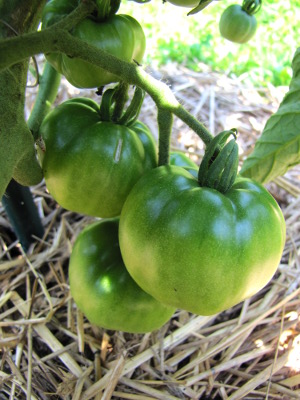
Why pretty tomatoes don't taste as good
 Are you looking for the
world's tastiest tomato? (Who isn't?) If so, a
new study suggests
you should choose the uglier varieties that don't turn evenly red.
Are you looking for the
world's tastiest tomato? (Who isn't?) If so, a
new study suggests
you should choose the uglier varieties that don't turn evenly red.
If your full-grown but
green tomatoes look like the ones pictured in this post, you're in
luck. The darker green top means that portion of the tomato is
full of chloroplasts, busy spinning straw into gold....er, I mean,
sunlight into sugars.
Supermarket tomatoes, in
contrast, have been bred to ditch the dark green top.
Agrobusinesses have found that consumers are more prone to select a
tomato that's a solid red color rather than having a tinge of green
around the stem.
Unfortunately, the same
gene that makes the tomatoes turn red uniformly means they don't get
that extra flavor boost. So, pretty tomatoes = insipid
flavor. Of course, there
are other factors that lead supermarket tomatoes to "taste like crap" (in the words of one of our
readers), but it's interesting to find out that variety selection does
matter.
(Yes, we have eaten two
remarkably early tommy-toe tomatoes. No, there's still no hint of
color on our larger plants.)
Want more in-depth information? Browse through our books.
Or explore more posts by date or by subject.
About us: Anna Hess and Mark Hamilton spent over a decade living self-sufficiently in the mountains of Virginia before moving north to start over from scratch in the foothills of Ohio. They've experimented with permaculture, no-till gardening, trailersteading, home-based microbusinesses and much more, writing about their adventures in both blogs and books.
Want to be notified when new comments are posted on this page? Click on the RSS button after you add a comment to subscribe to the comment feed, or simply check the box beside "email replies to me" while writing your comment.

Hi Anna and Mark! I've been lingering around for a while, I love your site and envy your way of life, not to mention where you live....southwest Virginia is beautiful country, bar none. Anyway, out of 50 tomato plants, different variety's, shapes and sizes, we have yet to get a ripe one without blossom end rot. Even some of our larger green ones are suffering. After much research (doesn't take much digging, BER seems to be a prevalent problem with an easy fix)I've decided that our garden soil is well below par. We've decided to use your raised bed techniques along with mulching to improve its organic quality, along with crushed eggshells to raise the calcium levels. We did mulch our pepper plants and they are doing fantastic. Our garden sits atop a pink quartz bed, so our soil is quite different than most Georgia red clay hard pack. Its very fine and sandy and I wonder if this isn't the reason why calcium has a hard time getting to our plants? Or if calcium is leached from the soil by the quartz? Either way, I plan on taking extra measures next year to ensure a large tomato harvest.
Also, do you ever grow any type of cow pea in your garden? We adore beans and cow peas and have had much success and large harvests from a few heirloom variety's. They are also easy to save seed from for next year. We started one variety 7 years ago with one packet of seed and haven't had to buy seed again.
Much blessings and continued success!
Ann
Even some of our larger green ones are suffering. After much research (doesn't take much digging, BER seems to be a prevalent problem with an easy fix)I've decided that our garden soil is well below par. We've decided to use your raised bed techniques along with mulching to improve its organic quality, along with crushed eggshells to raise the calcium levels. We did mulch our pepper plants and they are doing fantastic. Our garden sits atop a pink quartz bed, so our soil is quite different than most Georgia red clay hard pack. Its very fine and sandy and I wonder if this isn't the reason why calcium has a hard time getting to our plants? Or if calcium is leached from the soil by the quartz? Either way, I plan on taking extra measures next year to ensure a large tomato harvest.
Also, do you ever grow any type of cow pea in your garden? We adore beans and cow peas and have had much success and large harvests from a few heirloom variety's. They are also easy to save seed from for next year. We started one variety 7 years ago with one packet of seed and haven't had to buy seed again.
Much blessings and continued success!
Ann
Ann --- Even though blossom end rot is technically caused by a lack of calcium, the real root issue (no pun intended...) in your case might be water. If your plants can't take up as much water as they need, they won't get the calcium either, which leads to blossom end rot. We treated the issue in early years with eggshells (with no luck), but once we got our watering and mulching routine down so that our tomatoes no longer had to deal with drought stress, we stopped seeing the issue. Maybe the same will work for you!
We grew cowpeas as a cover crop one year, but haven't grown them to eat. I have to admit that I have my hands so full with the garden during the growing season that shelling beans or peas just seems beyond me!